Excavation Contractors Linton
Find top Land Excavation in Linton
Receive 3 FREE Excavation Companies quotes for your project today! Compare profiles, reviews, accreditations, portfolio, etc... and choose the best deal.
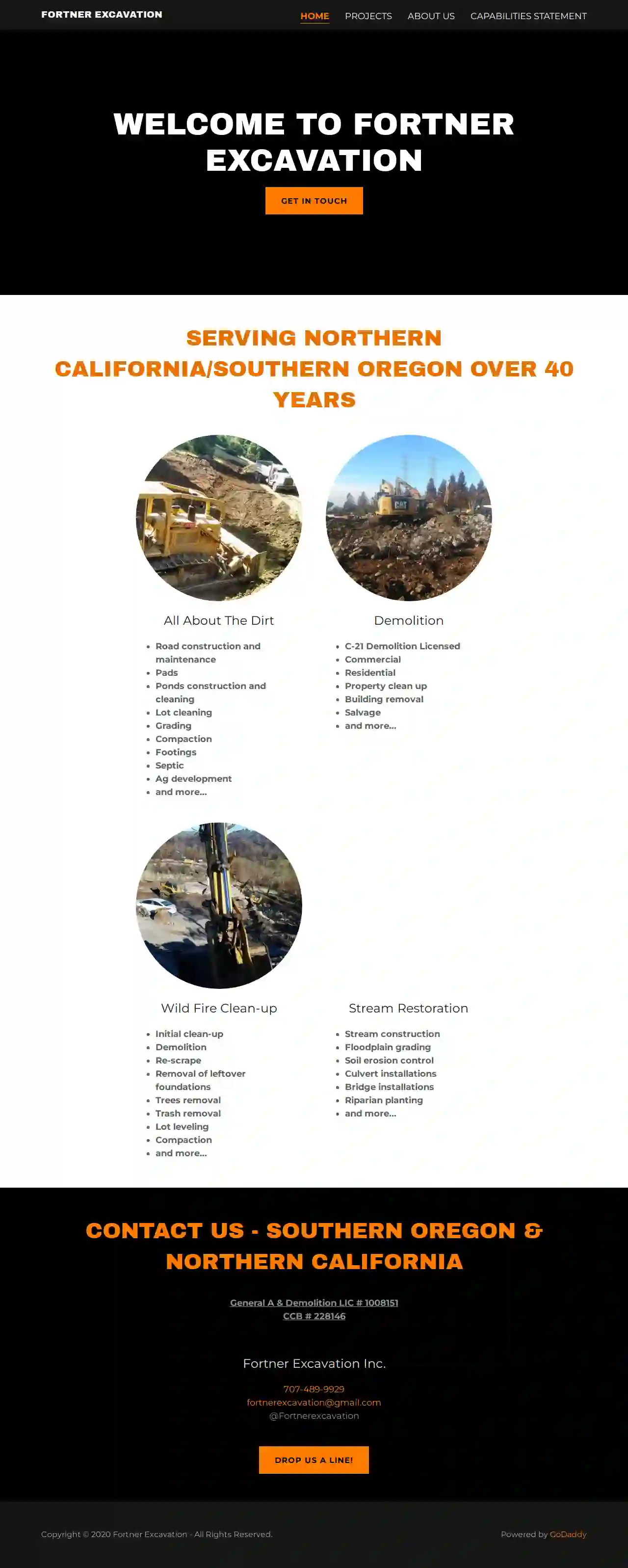
Fortner Excavation, Inc.
Chico, USAbout Us Bobby and Delaine Fortner started with 1 Backhoe and a beat up old Dump truck in December of 1979. They had a $300 payment on that backhoe and sweated every month to pay that payment. They loved it though. They wanted to be independent, self employed business owners. Since that time they have grown a little each year. Now in 2020, along with their 2 sons, they are continually making this business grow and evolve. Travis and Jeff are owners and Shareholders. We Are Expanding We are now located in the Medford and Southern Oregon area. Jeff Fortner is our “Go To Guy” for all the Jobs in that area. He is constantly working towards keeping the company running smoothly. Travis Fortner has a Tree Hedging company in addition to excavation at the Chico location and is still involved and bringing us lots of work and helping out on the side lines. Family Owned, Locally Grown We are 2nd and 3rd generation to Northern California. And we have expanded to Southern Oregon. We live and work here so we care about our customers and our quality of workmanship on every job. We are licensed to do excavation and demolition.
- Services
- Why Us?
- Our Team
- Gallery
Get Quote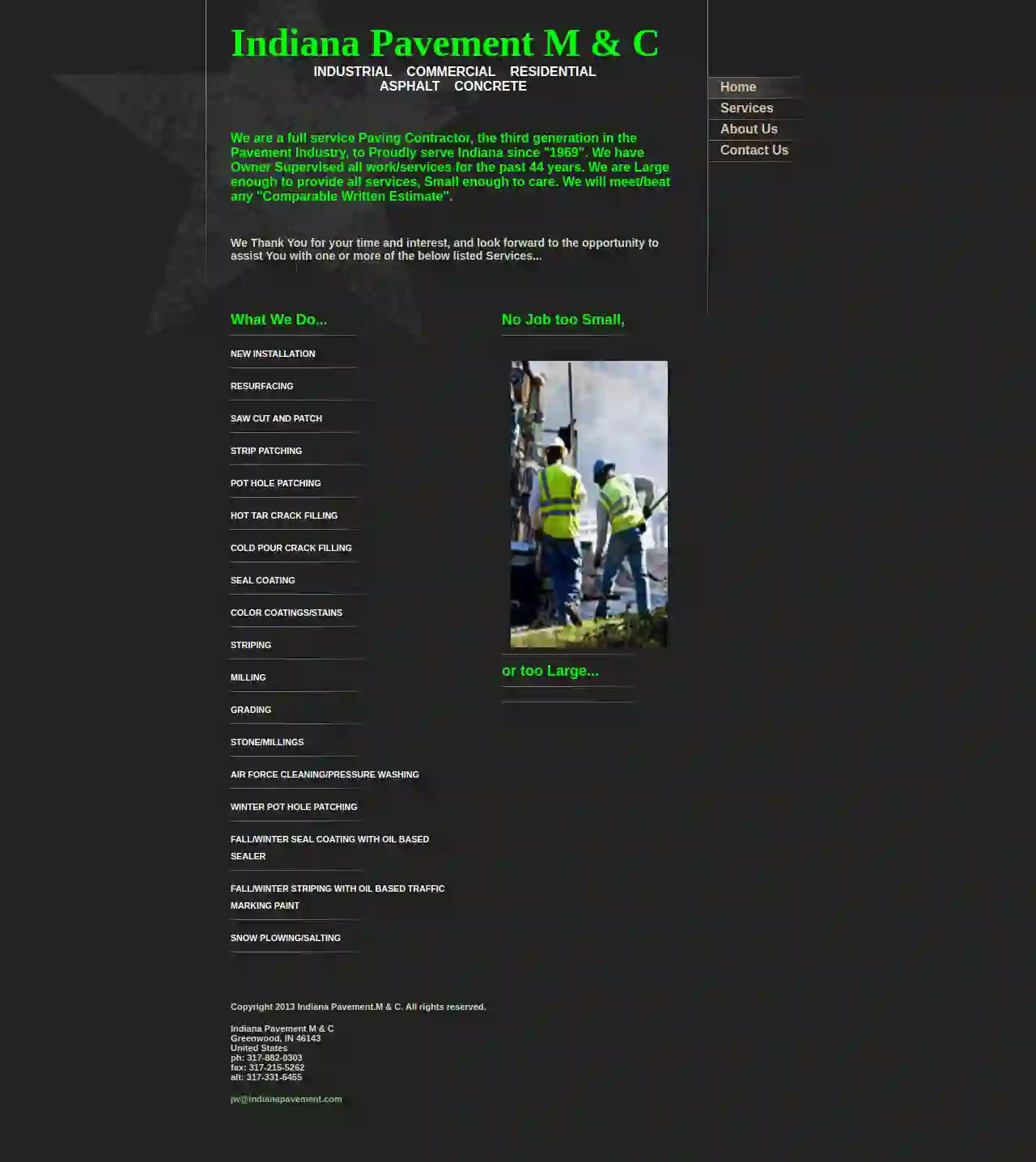
Indiana pavement M & C
4.325 reviewsGreenwood, 46143, USIndiana Pavement M & C: Your Trusted Paving Partner Indiana Pavement M & C is a family-owned and operated paving contractor with a rich history spanning three generations. Since 1969, we've been serving Indiana with pride, providing top-notch paving solutions for residential, commercial, and industrial clients. Our commitment to quality and customer satisfaction has earned us a reputation as a reliable and trustworthy partner in the pavement industry. We take pride in our owner-supervised approach, ensuring every project is completed to the highest standards. Our team is large enough to handle any project, yet small enough to provide personalized attention and care. We believe in transparency and offer competitive pricing, always striving to meet or beat any comparable written estimate. We are dedicated to providing a wide range of services to meet your specific needs. From new installations to repairs and maintenance, we have the expertise and experience to handle it all. We are committed to delivering exceptional results that enhance the beauty and functionality of your property. We understand the importance of protecting your investment. Our services, such as crack filling and seal coating, are designed to preserve your pavement and prevent costly repairs down the line. We are confident that our work will exceed your expectations and leave you with a lasting impression. Contact us today for a free consultation and estimate. We look forward to partnering with you on your next paving project.
- Services
- Why Us?
- Gallery
Get Quote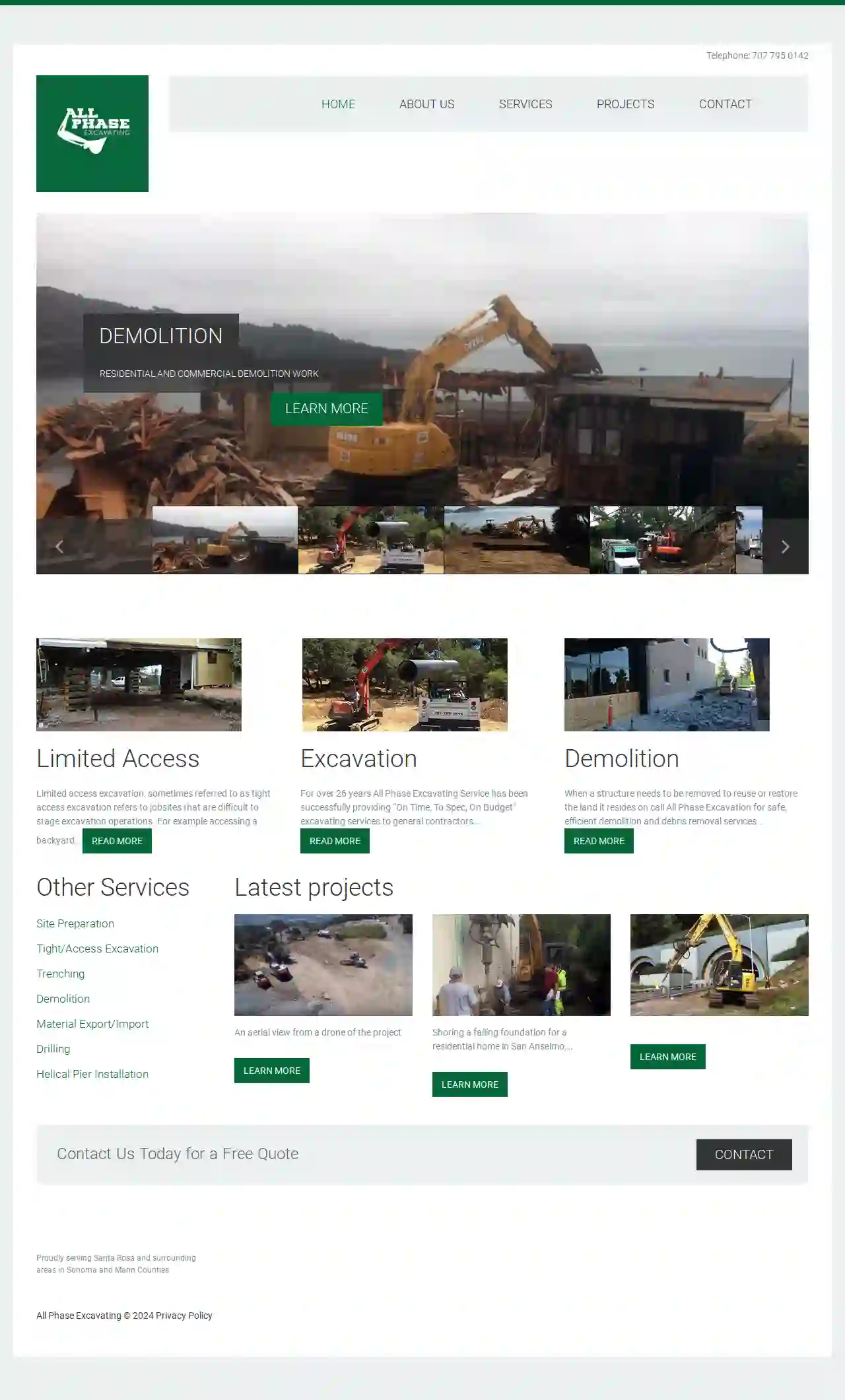
All Phase Excavating Inc
32 reviewsGary, USAbout All Phase Excavating "On time and on budget" is the goal of every excavation service company and at All Phase Excavation Service we add "done to perfection" to that tag line. When the carpenters show up to build the forms they'll find a site that is excavated to specifications, minimizing unnecessary work. We understand that a general contractor's primary concerns when selecting an excavation service include experience, capabilities, capacity, reliability, flexibility and of course a fair price. Excavation is typically the first task in starting a project and if that task is not performed to spec or is delayed it can have a serious impact on the success of the overall project. We understand the importance of being reliable and are prepared to perform the job as expected. The company started when founder and owner Vince Cheney launched All Phase Excavating in May of 1998 with a single bobcat and a pickup truck. He figured the way to be successful as a business owner is to do what you do best. "I really do enjoy excavating. I get a kick out of it and I decided that as I grew I would surround myself with other people who liked working excavation as much as I do." Serving Marin, Napa and Sonoma counties All Phase Excavating is headquartered in Penngrove with an equipment yard centrally located in Sonoma County. All Phase Excavating has grown from a single bobcat and a truck to 22 pieces of excavating and hauling equipment specifically acquired to tackle client needs. All Phase Excavating has the capability to tackle any excavating project large or small, from ground clearing to hauling debris. If It's an Excavating Challenge We Want a Shot at It As a general contractor you may not be overly concerned if your excavator is has a passion for moving earth but if you think about it, people who really enjoy their work are typically better at it than most. They see difficult jobs as a test of their skill and that's why we excel at tight access, hillside excavation, full and partial structure demolition and abatement and other demanding excavating projects. Vince is personally involved onsite in every project often working side by side with his crews. This onsite management involvement assures quality work and allows for streamlined communications with the general contractor. All Phase is a Responsible Community Business Is there a Californian that is not aware of the state's efforts to protect and improve our environment? At All Phase Excavation we are in full compliance with requirements with DPF requirements and our abatement service
- Services
- Why Us?
- Gallery
Get Quote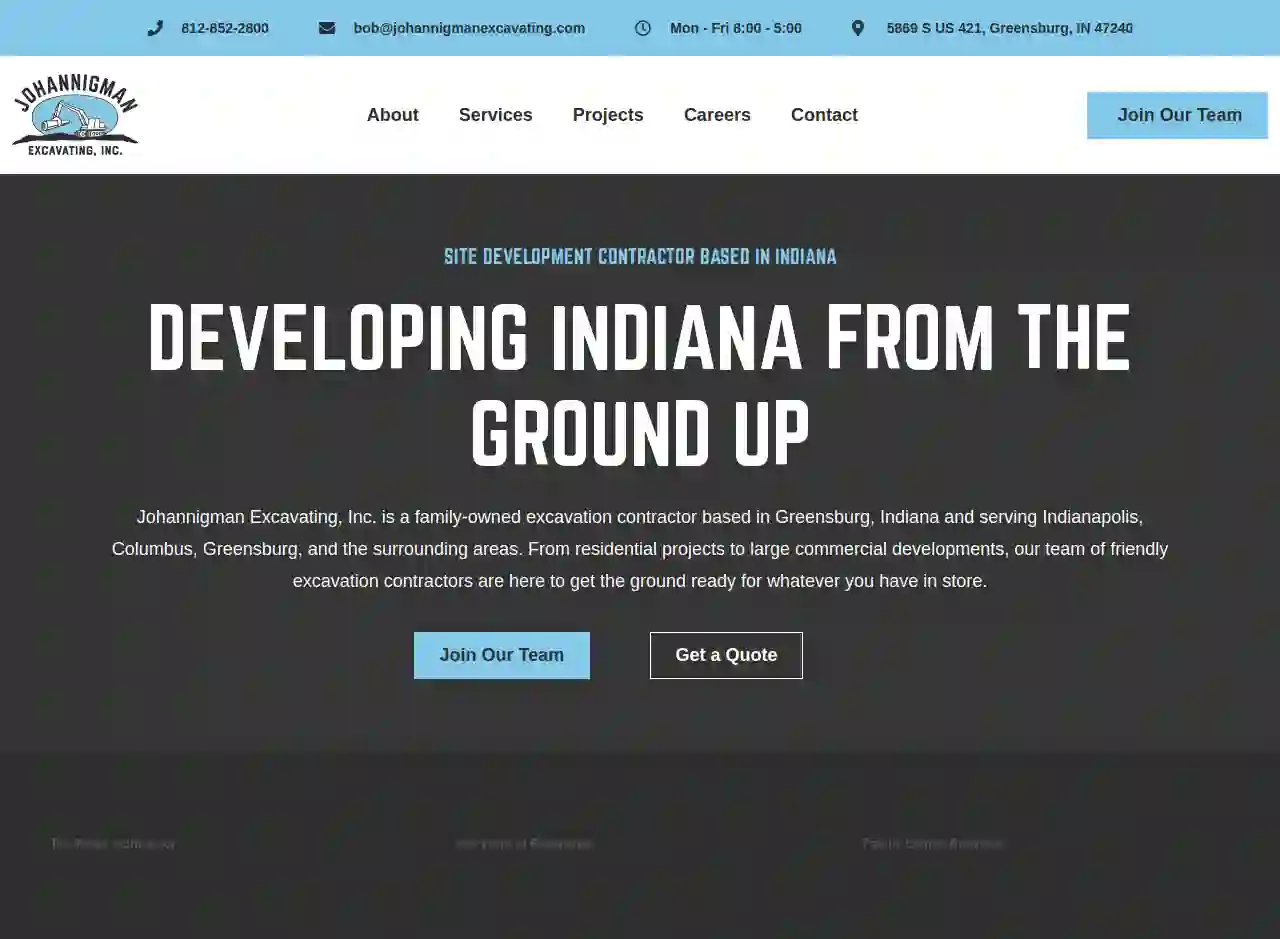
Johannigman Excavating, Inc
55 reviews5869 S US 421, Greensburg, 47240, USAbout Johannigman Excavating Johannigman Excavating, Inc. is a family-owned excavation contractor based in Greensburg, Indiana and serving Indianapolis, Columbus, Greensburg, and the surrounding areas. From residential projects to large commercial developments, our team of friendly excavation contractors are here to get the ground ready for whatever you have in store. Digging Deep for Indiana Since 1978 Our story begins with one man and his bulldozer over fifty years ago. Our grandfather, Roman Johannigman, was always on hand to help friends and neighbors clear and prepare their land for farming. In 1978, Roman handed over the keys to the dozer to his sons Ed and John – and Johannigman Excavating was born. Since then, we’ve been serving Indianapolis, Columbus, Greensburg, and their surrounding areas.
- Services
- Why Us?
- Gallery
Get Quote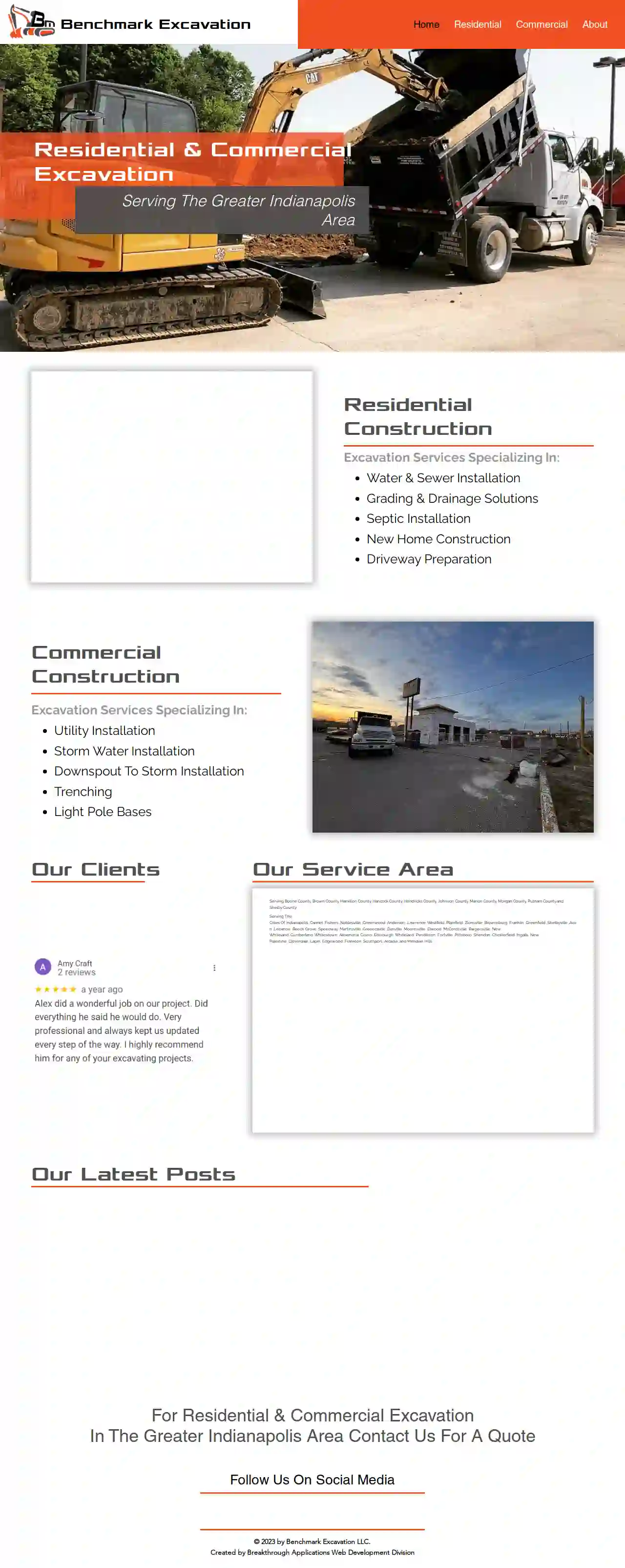
Benchmark Excavation LLC
517 reviewsIndianapolis, USBenchmark Excavation Serving Boone County, Brown County, Hamilton County, Hancock County, Hendricks County, Johnson County, Marion County, Morgan County, Putnam County, and Shelby County. Serving The Cities Of Indianapolis ,Carmel ,Fishers ,Noblesville ,Greenwood ,Anderson ,Lawrence ,Westfield ,Plainfield ,Zionsville ,Brownsburg ,Franklin ,Greenfield ,Shelbyville ,Avon ,Lebanon ,Beech Grove ,Speedway ,Martinsville ,Greencastle ,Danville ,Mooresville ,Elwood ,McCordsville ,Bargersville ,New Whiteland ,Cumberland ,Whitestown ,Alexandria ,Cicero ,Edinburgh ,Whiteland ,Pendleton ,Fortville ,Pittsboro ,Sheridan ,Chesterfield ,Ingalls ,New Palestine ,Cloverdale ,Lapel ,Edgewood ,Frankton ,Southport ,Arcadia ,and Meridian Hills. Our Clients Our Service Area Residential & Commercial Excavation Serving The Greater Indianapolis Area Contact Us Residential Construction Excavation Services Specializing In: Water & Sewer Installation Grading & Drainage Solutions Septic Installation New Home Construction Driveway Preparation Contact Us Today 1.310.703.4478 Commercial Construction Excavation Services Specializing In: Utility Installation Storm Water Installation Downspout To Storm Installation Trenching Light Pole Bases Contact Us Today 1.310.703.4478
- Services
- Why Us?
- Gallery
Get Quote
Brothers Excavating, LLC
51 reviewsIndianapolis, USAbout Brothers Excavating Brothers Excavating has the experience, the expertise, and the equipment to complete any size project from driveways to roads, drainage to erosion control, and yard grading to mass Excavation. Fully insured and bonded with more than 20 years in the business, Brothers Excavating is your on-time, on-target, and on-budget excavating contractor. We service a 75-mile radius, including: Indiana Terre Haute Indianapolis Lafayette Bloomington Vincennes Illinois Champaign Danville Effingham Mattoon Meet The Owner Don Bowers President – 30 years experience As a second-generation construction excavator, the desire to dig and build is in my bones. Couple that with an entrepreneurial spirit lead to the development of Brother’s Excavating with a goal to bring a professional and progressive approach to this industry with experience and the latest technology. Furthermore, I measure success by customer satisfaction throughout the entire building cycle rather than just the end result
- Services
- Why Us?
- Our Team
- Testimonials
- Gallery
Get Quote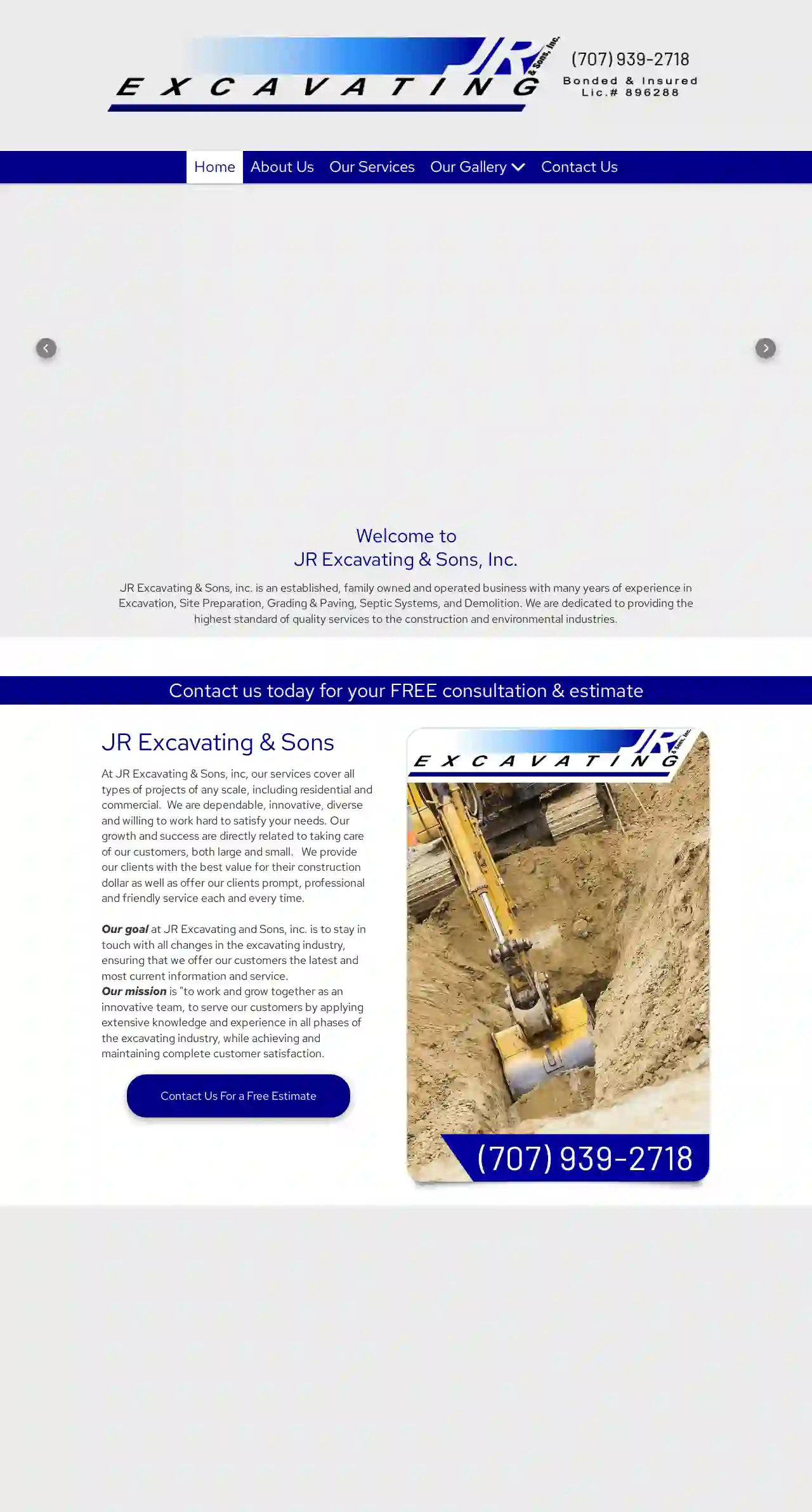
J R Excavating & Sons Inc
54 reviews120 Meadowlark Lane, Sonoma, 95476, USJR Excavating & Sons, Inc. is a family-owned and operated business with years of experience in excavation, site preparation, grading & paving, septic systems, and demolition. We are dedicated to providing the highest standard of quality services to the construction and environmental industries. Our services cover all types of projects of any scale, including residential and commercial. We are dependable, innovative, diverse and willing to work hard to satisfy your needs. Our growth and success are directly related to taking care of our customers, both large and small. We provide our clients with the best value for their construction dollar as well as offer our clients prompt, professional and friendly service each and every time. Our goal at JR Excavating and Sons, inc. is to stay in touch with all changes in the excavating industry, ensuring that we offer our customers the latest and most current information and service. Our mission is "to work and grow together as an innovative team, to serve our customers by applying extensive knowledge and experience in all phases of the excavating industry, while achieving and maintaining complete customer satisfaction."
- Services
- Why Us?
- Our Team
- Gallery
Get Quote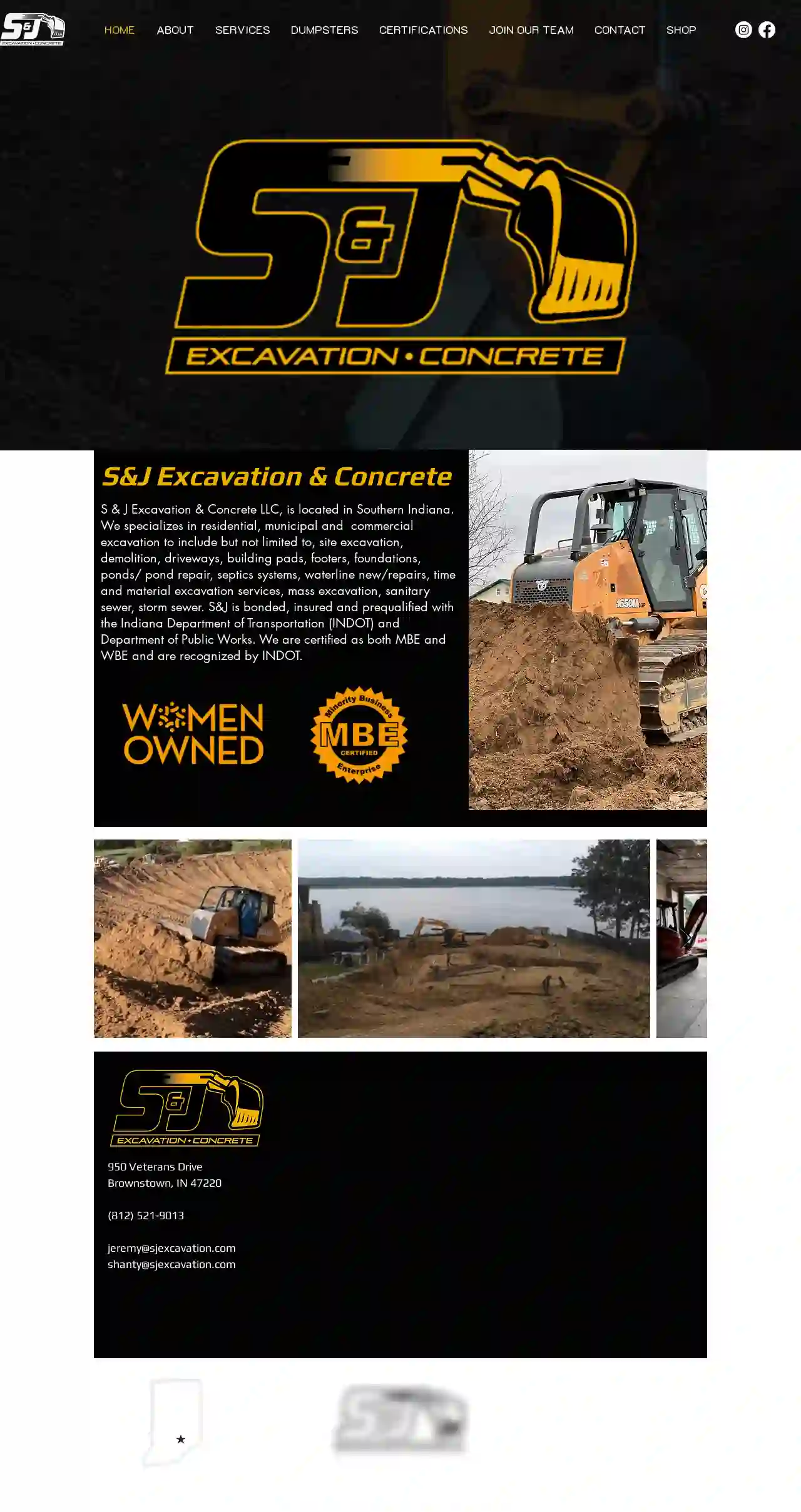
S & J EXCAVATION AND CONCRETE LLC
4.712 reviews950 Veterans Drive, Brownstown, 47220, USS&J Excavation & Concrete S & J Excavation & Concrete LLC, is located in Southern Indiana. We specialize in residential, municipal and commercial excavation to include but not limited to, site excavation, demolition, driveways, building pads, footers, foundations, ponds/ pond repair, septics systems, waterline new/repairs, time and material excavation services, mass excavation, sanitary sewer, storm sewer. S&J is bonded, insured and prequalified with the Indiana Department of Transportation (INDOT) and Department of Public Works. We are certified as both MBE and WBE and are recognized by INDOT.
- Services
- Why Us?
- Gallery
Get Quote
Excavation DHS
2035 Butte House Rd, Yuba City, 95993, USBegin Your Excavation Journey With DHS Explore the possibilities with Heavy Handyman Division. Contact us to receive a personalized excavation quote that meets your project's specific requirements, completely free of charge. Company Overview: At Heavy Handyman Division, we have been providing top-notch excavation and site preparation services since our inception. Our team is equipped with the knowledge and machinery to handle all your site work needs efficiently. Serving a wide area including Sacramento, Chico, Roseville, and many other locations within a 50 to 60-mile radius from Yuba City, California, we are your dedicated excavation specialists. We offer precise and environmentally conscious excavation services for both residential and commercial projects. Leveraging our expertise, we ensure your project is completed on time and within budget, exceeding your expectations.
- Services
- Why Us?
- Testimonials
- Gallery
Get Quote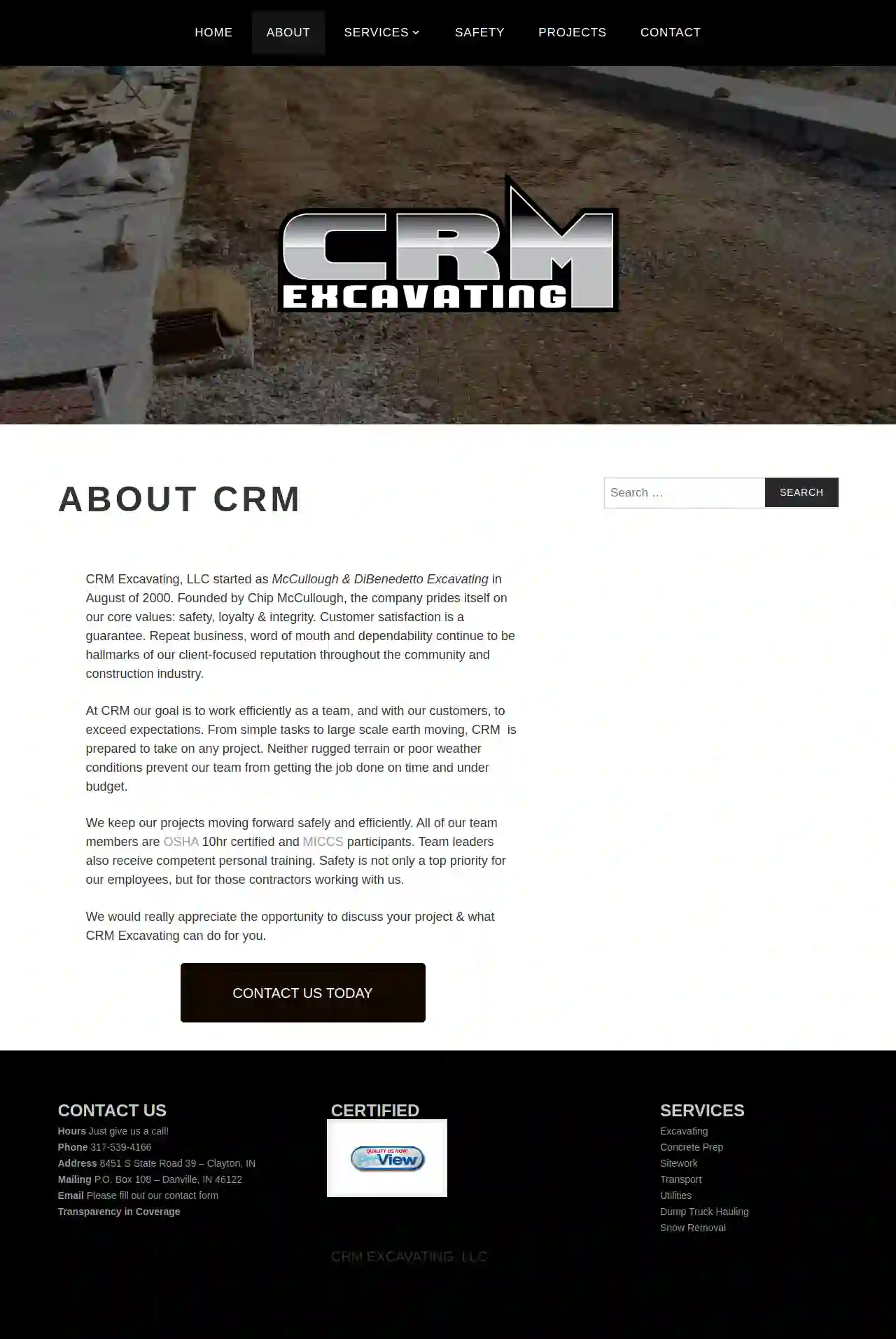
CRM Excavating
4.99 reviews8451 S State Rd 39, Clayton, 46118, USAbout CRM Excavating CRM Excavating, LLC started as McCullough & DiBenedetto Excavating in August of 2000. Founded by Chip McCullough, the company prides itself on our core values: safety, loyalty & integrity. Customer satisfaction is a guarantee. Repeat business, word of mouth and dependability continue to be hallmarks of our client-focused reputation throughout the community and construction industry. At CRM our goal is to work efficiently as a team, and with our customers, to exceed expectations. From simple tasks to large scale earth moving, CRM is prepared to take on any project. Neither rugged terrain or poor weather conditions prevent our team from getting the job done on time and under budget. We keep our projects moving forward safely and efficiently. All of our team members are OSHA 10hr certified and MICCS participants. Team leaders also receive competent personal training. Safety is not only a top priority for our employees, but for those contractors working with us. We would really appreciate the opportunity to discuss your project & what CRM Excavating can do for you.
- Services
- Why Us?
- Gallery
Get Quote
Over 22,076+ Excavation Companies on our directory
Our excavation companies operate in Linton & surroundings!
ExcavationHQ has curated and vetted Top Excavation Contractors in and around Linton. Find a top & trustworthy business today.
Frequently Asked Questions About Excavation Contractors
- Project Size and Scope: Larger, more complex excavations naturally take longer.
- Soil Conditions: Rocky or challenging soil types can slow down progress.
- Site Accessibility: Limited access might require more time for maneuvering equipment and hauling materials.
- Weather: Inclement weather can cause delays.
- Permitting and Inspections: Waiting for permits or inspections can extend the timeline.
- Sloped Property: Your property has a significant slope, making it prone to soil erosion or landslides.
- Creating Usable Space: You want to level off a sloped area to create a flat surface for patios, gardens, or other outdoor spaces.
- Preventing Damage: Erosion is threatening existing structures, driveways, or walkways.
- Landscaping Features: You're incorporating tiered gardens, raised beds, or other landscaping elements requiring soil retention.
- Soil Type and Stability: Stable, cohesive soils allow for deeper excavations than loose or unstable soils.
- Groundwater Level: Excavations below the water table require dewatering techniques to manage water intrusion.
- Equipment and Resources: The size and capabilities of excavation equipment influence the achievable depth.
- Safety Regulations: OSHA and other safety regulations impose limitations on trench depths without proper shoring or sloping.
- Project Requirements: The purpose of the excavation (basement, pool, foundation) determines the necessary depth.
How long does an excavation project take?
How do I know if I need a retaining wall?
What is the difference between excavation and grading?
Excavation: Primarily involves removing earth or other materials from a site. It's about digging down and creating space.
Grading: Focuses on shaping and leveling the ground to a specific slope or elevation. It's about adjusting the existing terrain.
For example, you might excavate a foundation and then grade the surrounding area to ensure proper drainage and a level surface for landscaping.
How deep can you excavate?
How long does an excavation project take?
- Project Size and Scope: Larger, more complex excavations naturally take longer.
- Soil Conditions: Rocky or challenging soil types can slow down progress.
- Site Accessibility: Limited access might require more time for maneuvering equipment and hauling materials.
- Weather: Inclement weather can cause delays.
- Permitting and Inspections: Waiting for permits or inspections can extend the timeline.
How do I know if I need a retaining wall?
- Sloped Property: Your property has a significant slope, making it prone to soil erosion or landslides.
- Creating Usable Space: You want to level off a sloped area to create a flat surface for patios, gardens, or other outdoor spaces.
- Preventing Damage: Erosion is threatening existing structures, driveways, or walkways.
- Landscaping Features: You're incorporating tiered gardens, raised beds, or other landscaping elements requiring soil retention.
What is the difference between excavation and grading?
Excavation: Primarily involves removing earth or other materials from a site. It's about digging down and creating space.
Grading: Focuses on shaping and leveling the ground to a specific slope or elevation. It's about adjusting the existing terrain.
For example, you might excavate a foundation and then grade the surrounding area to ensure proper drainage and a level surface for landscaping.
How deep can you excavate?
- Soil Type and Stability: Stable, cohesive soils allow for deeper excavations than loose or unstable soils.
- Groundwater Level: Excavations below the water table require dewatering techniques to manage water intrusion.
- Equipment and Resources: The size and capabilities of excavation equipment influence the achievable depth.
- Safety Regulations: OSHA and other safety regulations impose limitations on trench depths without proper shoring or sloping.
- Project Requirements: The purpose of the excavation (basement, pool, foundation) determines the necessary depth.